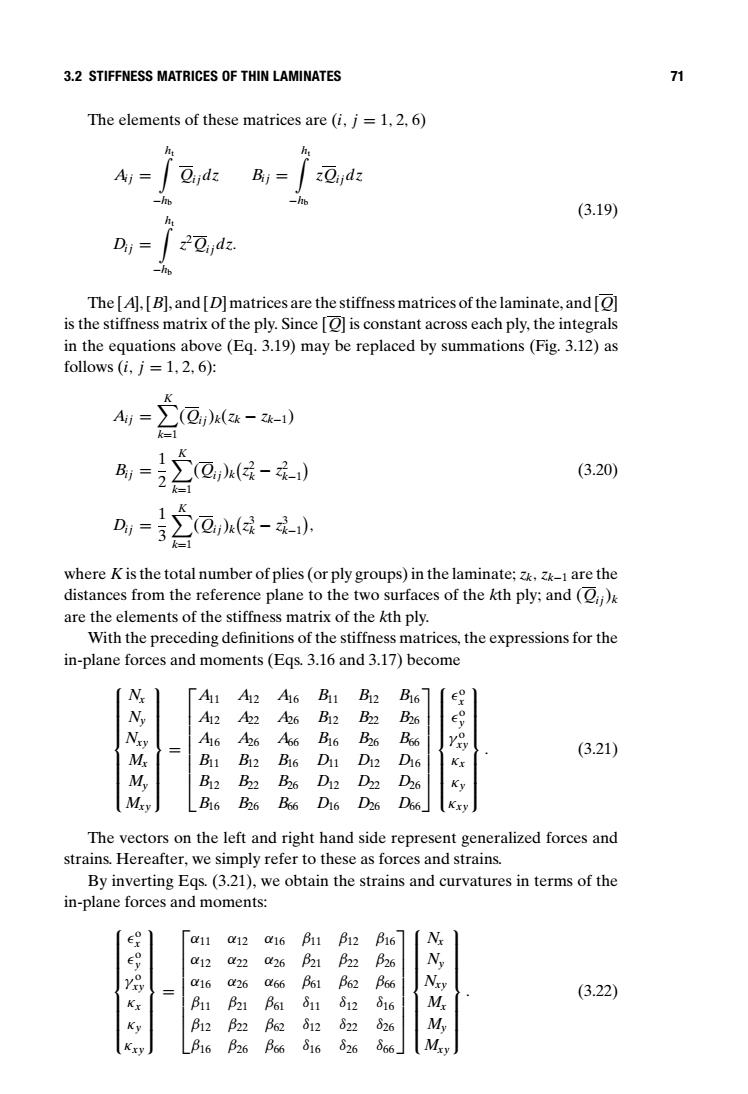正在加载图片...

3.2 STIFFNESS MATRICES OF THIN LAMINATES 71 The elements of these matrices are (i,j=1,2,6) (3.19) The [A],[B],and [D]matrices are the stiffness matrices of the laminate,and[] is the stiffness matrix of the ply.Since [O]is constant across each ply,the integrals in the equations above (Eq.3.19)may be replaced by summations(Fig.3.12)as follows(i,j=1,2,6)月 g=20(4-4 B=20- (3.20) 1 K D=2@,k-小 where K is the total number of plies(or ply groups)in the laminate;zk,Zk-1 are the distances from the reference plane to the two surfaces of the kth ply;and are the elements of the stiffness matrix of the kth ply. With the preceding definitions of the stiffness matrices,the expressions for the in-plane forces and moments(Egs.3.16 and 3.17)become N Au 42A16 B11 B12 B16 42 b226 B12 B22 B26 N A6 426 A66 B16 B26 Boo Y8 (3.21) M B11 B12B16 Di1 D12 D16 Kx M B12 B2 B26 D12 D22 D26 Ky Mxy B16 B26 B66 D16 D26 D66」 Kxy The vectors on the left and right hand side represent generalized forces and strains.Hereafter,we simply refer to these as forces and strains. By inverting Eqs.(3.21),we obtain the strains and curvatures in terms of the in-plane forces and moments: C11 012 C16 P11 B12 B16 N c12 c22 026 P21 B22 P26 N c16 a26 066 P61 F62 B66 B B21 B61 S d12 d16 (3.22) 12 B22 Be2 612 i26 M Kxy LB1 p26 B66 816 d26 866」3.2 STIFFNESS MATRICES OF THIN LAMINATES 71 The elements of these matrices are (i, j = 1, 2, 6) Ai j = ) ht −hb Qi jdz Bi j = ) ht −hb zQi jdz Di j = ) ht −hb z2Qi jdz. (3.19) The [A], [B], and [D] matrices are the stiffness matrices of the laminate, and [Q] is the stiffness matrix of the ply. Since [Q] is constant across each ply, the integrals in the equations above (Eq. 3.19) may be replaced by summations (Fig. 3.12) as follows (i, j = 1, 2, 6): Ai j = * K k=1 (Qi j)k(zk − zk−1) Bi j = 1 2 * K k=1 (Qi j)k z2 k − z2 k−1 (3.20) Di j = 1 3 * K k=1 (Qi j)k z3 k − z3 k−1 , where K is the total number of plies (or ply groups) in the laminate; zk, zk−1 are the distances from the reference plane to the two surfaces of the kth ply; and (Qi j)k are the elements of the stiffness matrix of the kth ply. With the preceding definitions of the stiffness matrices, the expressions for the in-plane forces and moments (Eqs. 3.16 and 3.17) become Nx Ny Nxy Mx My Mxy = A11 A12 A16 B11 B12 B16 A12 A22 A26 B12 B22 B26 A16 A26 A66 B16 B26 B66 B11 B12 B16 D11 D12 D16 B12 B22 B26 D12 D22 D26 B16 B26 B66 D16 D26 D66 o x o y γ o xy κx κy κxy . (3.21) The vectors on the left and right hand side represent generalized forces and strains. Hereafter, we simply refer to these as forces and strains. By inverting Eqs. (3.21), we obtain the strains and curvatures in terms of the in-plane forces and moments: o x o y γ o xy κx κy κxy = α11 α12 α16 β11 β12 β16 α12 α22 α26 β21 β22 β26 α16 α26 α66 β61 β62 β66 β11 β21 β61 δ11 δ12 δ16 β12 β22 β62 δ12 δ22 δ26 β16 β26 β66 δ16 δ26 δ66 Nx Ny Nxy Mx My Mxy . (3.22)